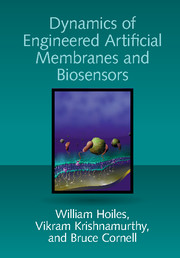Book contents
- Frontmatter
- Contents
- Preface
- List of Abbreviations
- Part I Introduction and Background
- Part II Building Engineered Membranes, Devices, and Experimental Results
- 4 Formation of Engineered Tethered Membranes
- 5 Ion-Channel Switch (ICS) Biosensor
- 6 Physiochemical Membrane Platforms
- 7 Experimental Measurement Methods for Engineered Membranes
- Part III Dynamic Models for Artificial Membranes: From Atoms to Device
- Appendices
- Bibliography
- Index
7 - Experimental Measurement Methods for Engineered Membranes
from Part II - Building Engineered Membranes, Devices, and Experimental Results
Published online by Cambridge University Press: 25 May 2018
- Frontmatter
- Contents
- Preface
- List of Abbreviations
- Part I Introduction and Background
- Part II Building Engineered Membranes, Devices, and Experimental Results
- 4 Formation of Engineered Tethered Membranes
- 5 Ion-Channel Switch (ICS) Biosensor
- 6 Physiochemical Membrane Platforms
- 7 Experimental Measurement Methods for Engineered Membranes
- Part III Dynamic Models for Artificial Membranes: From Atoms to Device
- Appendices
- Bibliography
- Index
Summary
Introduction
In previous chapters we described how to construct engineered membranes and devices including the ion-channel switch biosensor, electroporation measurement platform, and electrophysiological response platform. An important question is: How can one verify that the artificial membranes constructed in previous chapters have the precisely engineered structure that we have claimed? This chapter focuses on how experimental measurements can be performed on engineered membranes to estimate important biological parameters such as the membrane conductance and capacitance, and also how such measurements can be used to verify the structure of the membrane. We describe three important measurement methods to determine the properties of engineered membranes:
(i) impedance measurements,
(ii) time-dependent electrical measurements, and
(iii) spectroscopy and imaging techniques.
Impedance measurement and time-dependent electrical measurement techniques require minimal experimental setup and low-cost laboratory equipment compared with optical and imaging techniques. For example, a standard computer sound card can be used to perform impedance measurements; in comparison, spectroscopic and imaging techniques require both labor-intensive experimental setup and access to equipment that can perform fluorescence correlation spectroscopy, X-ray and neutron reflectometry, and electron microscopy. In practice this is why either impedance measurements or time-dependent electrical measurements are used for estimating properties of engineered membranes. The measurement methods in this chapter also play an important role in Part III, where we construct dynamic models of engineered membranes which can be used to relate the experimental measurements from tethered membranes to biological parameters of interest (e.g., reaction pathway of pore-forming peptides, the concentration estimation of analyte species, and the population and dynamics of aqueous pores in the membrane).
Electrical Response of Engineered Membranes
A very useful yet straightforward procedure for performing measurements of an engineered membrane is to apply an excitation potential across the membrane and then record the current response. Indeed, in Part III, we construct mathematical models for the electrical response of engineered membranes at several levels of abstraction (from atoms to device).
When the engineered tethered membrane is excited by a low-level (below 50 mV) external alternating voltage, the ions in the electrolyte solution migrate to and from the gold electrode surface and insulating barrier of the membrane. Additionally, ions can also pass through aqueous pores and ion channels in the membrane.
Information
- Type
- Chapter
- Information
- Dynamics of Engineered Artificial Membranes and Biosensors , pp. 118 - 136Publisher: Cambridge University PressPrint publication year: 2018
